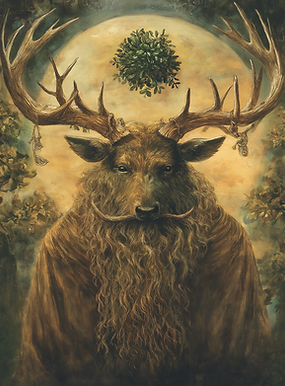
The Horned God


This relationship is seen as nurturing a deeper connection with nature, understanding of natural cycles, and integration of all aspects of self - both 'civilized' and 'wild'. The Horned God serves as a reminder of humanity's primal roots and our interconnectedness with all life.
The Horned God isn’t viewed as a transcendent deity, but as an immanent presence that can be experienced directly in nature. His energy is felt in the wildness of a storm, the power of a waterfall, or the quiet strength of an old-growth forest.

The Horned God
Nature and Attributes
The Horned God represents the masculine principle in nature, embodying wildness, virility, and the untamed aspects of the natural world. He is a complex figure, encompassing both the fierce and gentle sides of nature. Unlike monotheistic male deities, the Horned God is deeply connected to the cycles of nature, particularly those of death and rebirth.
Seasonal Associations
- Strongly linked to autumn and winter
- Celebrated at Lammas/Lughnasadh as the sacrificial god of the harvest
- Honored at Samhain as the lord of death and the underworld
- 'Reborn' at Yule (winter solstice)
Magical Associations
- Invoked in spells for male fertility, strength, and courage
- Associated with animal magic and shapeshifting
- Used in rituals for connecting with one's 'wild' nature
Relationship to Other Figures
- Often seen as the consort of the Earth Mother or Moon Goddess
- In some interpretations, he's the son/lover of the Goddess, dying and being reborn each year
- Guardian and king of nature spirits and animals
Personal Work
- Exploring and integrating one's own 'wild' nature
- Developing a deeper connection with animals and the natural world
- Working with personal shadow aspects
- Cultivating strength, courage, and healthy expressions of masculinity
1. Spending time in wild places
2. Responsible hunting or foraging practices
3. Ecstatic dance or drumming to connect with one's 'wild' self
4. Animal totem work
5. Rites of passage rituals, particularly for men
Iconography and Symbols
- Often depicted as a man with antlers or horns, sometimes with animal features
- Associated with forest animals, particularly deer, elk, bulls, and goats
- Symbols include antlers, horns, spears, and pine cones
- Colours associated are deep greens, browns, and occasionally red
Aspects and Roles
1. The Hunter: Provider and protector
2. The Wild Man: Embodiment of untamed nature and freedom
3. The Dying God: Representing the cycle of sacrifice and renewal in nature
4. Lord of Animals: Patron of wildlife and animal spirits
Rituals and Celebrations
1. Autumn Equinox: Honoring the Horned God as he prepares for his descent into the underworld
2. Samhain: Rituals focusing on death, ancestors, and the wisdom of the otherworld
3. Winter Solstice: Celebrating his rebirth
4. Hunting rituals: Asking for blessing and giving thanks for the sacrifice of animals
Ethical Implications
- Encourages respect for the balance of life and death in nature
- Promotes understanding of mankind's place within, not above, the natural world
- Associated with responsible stewardship of wildlife and wild places
Modern Interpretations
- Sometimes linked with conservation efforts, particularly wildlife preservation
- Seen as a model for eco-conscious masculinity
- His cycle of death and rebirth might be interpreted as a metaphor for personal transformation




